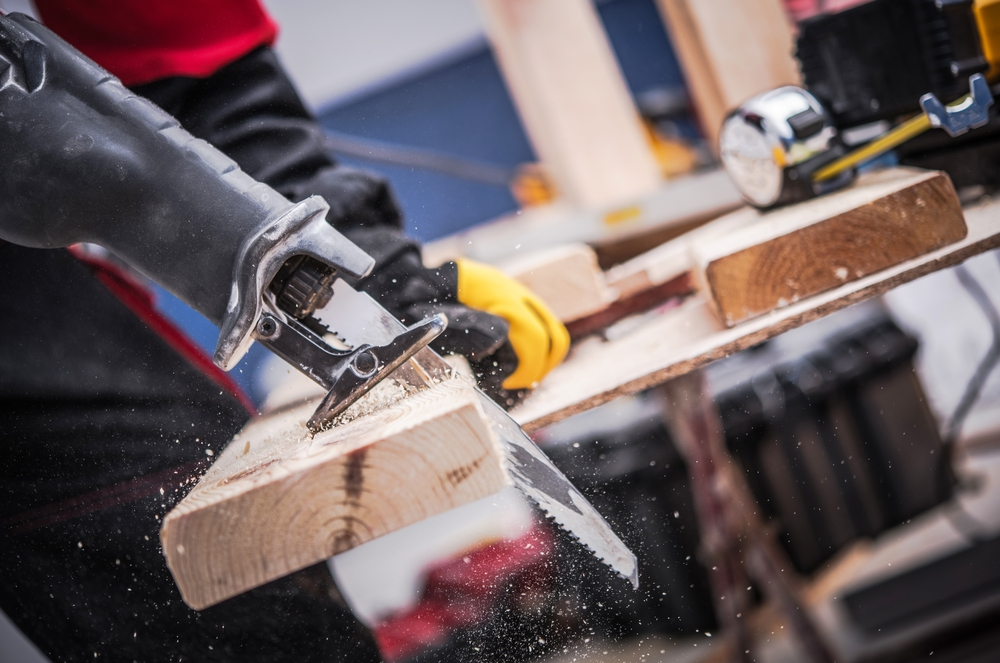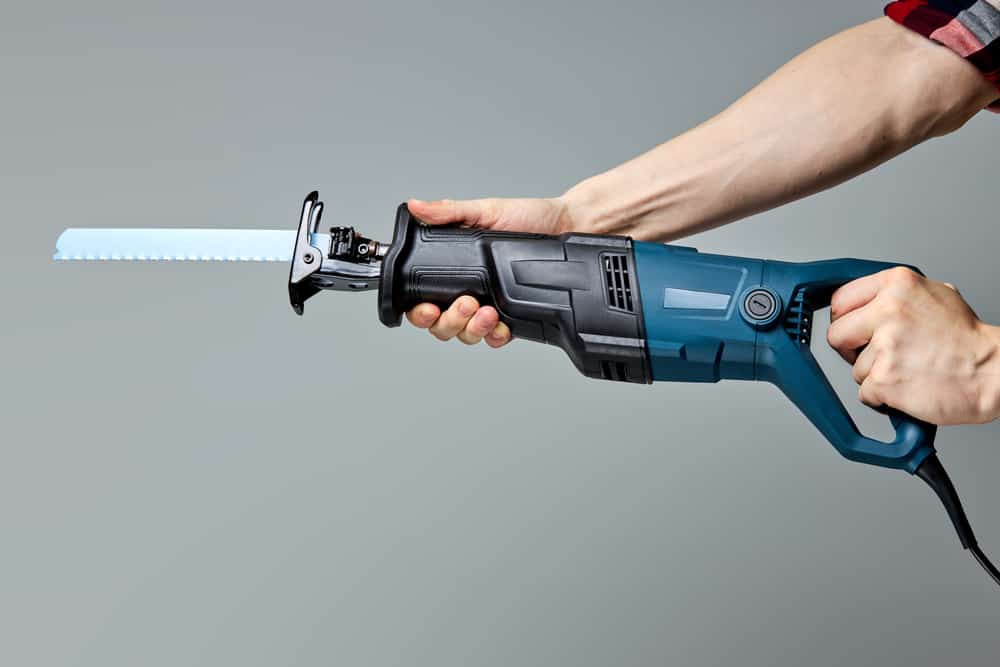Reciprocating saws cut the wood in straight lines. Choose the right blade and the correct saw technique so you will not have to wonder how to use a reciprocating saw to cut wood straight.
When cutting straight with a reciprocating saw, mark a line upon the material you are cutting with using a tape measure and permanent marker. You have more visibility, although not in all situations. Hold the reciprocating saw in front of you in line with your stomach, press the shoe against the material, and align the blade to the marked line closely.

Angle the saw slightly downwards to start ripping through the material. What determines the ripping pace is the pressure you have applied. Try cutting through the material using your body rather than your arms to guide the cut. Your body can provide more stability than your arms, especially under fatigue.
Many features are designed within some reciprocating saws to aid in a straight cut. These features are on models which cater to all affordability options. That is an added advantage. They also promote the safety and longevity of your tool. Key features include:
- Anti-vibration handles,
- LED lighting for dark workspaces,
- Adjustable pivoting shoes,
- Blade clamps,
- and variable-speed triggers.
How does a reciprocating saw work?
A reciprocating saw is a machine-powered saw in which the cutting action through a push-and-pull motion of the blade. That is the reciprocating movement. The term applies to a saw used in construction and demolition work.
Blade selection is the first step when using a reciprocating saw. Start by identifying what the material will be that you are cutting. Select the right blade for the task. Sometimes you are unsure and need to refer to the blade information attached to the saw.
After choosing the blade, insert the saw blade into the saw and mount it. The process sounds complicated, but it is easy. Complete the process by inserting the back end of the saw blade into the blade slot. That is in front of the saw.
Secure the blade saw by the blade clamp. Access your blade clamp, and use it to secure the saw blade in place firmly. Pull on the saw blade’s front end to ensure it is secure before proceeding.
Move on to the shoe as you adjust it. Ensure you have the shoe set to where it needs to be before cutting. When cutting into hard material, you may want to angle the shoe more to give the blade a sharper angle.
Also, adjust the blade depth. When making freehand cuts on exposed nails and lumber pieces, the depth does not matter, but it is necessary when cutting into a wall. You would not want your blade to go through and out the other side. Setting the shoe prevents it from doing so.

Squeeze the trigger to activate the saw blade. What makes a reciprocating saw is a right blade, angle, and shoe set. If you are cutting piping, or larger wood pieces, start the saw blade off slow and then increase speed.
Now you can cut. Apply even pressure in any direction you are moving the blade. Try to keep it controlled throughout the cutting process. That does not take more than a few seconds.
How to cut straight with a reciprocating saw
To saw straight with a reciprocating saw, you need to follow a few simple steps:
- Choose the right saw blade: The first step to sawing straight with a reciprocating saw is choosing the blade. Make sure you choose an appropriate blade for the material you are cutting. For example, if you are cutting wood, you should use a blade suitable for wood.
- Mark your cut: before you start cutting, mark the line you want to cut. Use a ruler or carpenter’s square to ensure the line is straight and accurate.
- Secure the material: Make sure the material you are cutting is securely clamped or held in place. This will prevent it from moving during cutting.
- Begin cutting: Cut slowly, ensuring the saw blade is aligned with the marked line. Move the saw back and forth along the marked line with a smooth and controlled motion.
- Follow the instructions: After cutting, follow the cut to the end. Do not stop or lift the saw until you have finished the cut.
- Use both hands: when using a reciprocating saw, you must use both hands to maintain control. Hold the handle of the saw with one hand and guide the saw along the cut line with the other hand.
- Practice makes perfect: Straight cuts with a reciprocating saw require practice. The more you use the saw, the better you will become at cutting straight lines.
If you follow these steps, you can make straight cuts with a reciprocating saw. Always wear proper protective equipment, such as eye and hearing protection, and follow all manufacturer instructions and safety guidelines.
Can I use a reciprocating saw to cut a 2×4?
Yes, a reciprocating saw cuts through your 2x4s easily. There is no need to change blades after cutting a few 2x4s. You can even borrow a saw from a friend to assess the saw. Even a wrong saw blade should easily handle a 2×4.
What is the difference between a jigsaw and a reciprocating saw?
Jigsaws have long, slim blades and are ideal for jobs requiring delicate woodcuts. Reciprocating saws have a horizontal blade action for rough cutting and demolition jobs, such as cutting wood and metal.
They both cut through materials and offer alternative blades for different projects. The reciprocating saw always cuts through thicker materials. It works as a handheld tool, while the jigsaw requires a level surface.
Using a jigsaw for flush cuts does not yield better results, just like you might not go for reciprocating saws for precision cutting. Top reciprocating saws allow you to angle the saw to suit the cuts because of the handheld design. They don’t require angling the material to suit the position of a saw like a jigsaw. That increases the versatility and convenience of using a reciprocating saw compared to a jigsaw.
How do you cut angles with a reciprocating saw?
It is hard to find your angles and draw lines on all the sides needed, but you can still cut angles with the saw. Start cutting slowly, check your line, and ensure your saw blade is sharp.
Why does my reciprocating saw vibrate
The rough demolition style cutting that reciprocating saws are for creates a lot of vibration. As the blade moves, it creates a lot of vibration. As it moves from its most retracted state to full extension and back again, that action reacts with the tool. You cannot avoid vibration from a working reciprocating saw, but more vibration comes with improperly using the saw blade. Blades for reciprocating saws come in different lengths for a reason.
Cutting smaller material with longer blades causes the end of the saw blade to move aggressively back and forth. That results in a slower cut, and the vibration leads to a bent blade. Continual use brings more vibration that is irritating. In other words, reduce the load for the day or take breaks to avoid irritation.
- Grain and Sheen: Teak Oil versus Danish Oil Uncovered - January 10, 2024
- The Cherry on Top: Crafting the Perfect Cutting Board - January 9, 2024
- Polyurethane Water-Based vs Oil-Based: Choosing the Right Finish - January 8, 2024